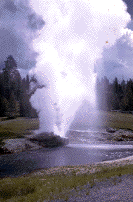Class Notes - Groundwater

Introduction
As emphasized previously, water is a remarkable compound. This chapter focuses on water beneath the surface which is part of the groundwater system. Caves and caverns often offer spectacular evidence of some of the influences of ground water. Avoid having to get wet in the dark and explore a Virtual Cave at the link in the Chapter Heading.
You may find this Glossary of Water-Related Terms helpful as you read the following material.
Terminology
Groundwater moves under the influence of gravity. If the water table intersects the surface a spring is formed. Under the proper circumstances an artesian well may form. In an artesian system the groundwater is confined between impermeable units (aquiludes). A well whose top is above the artesian-pressure surface will flow freely.
Geysers are an interesting phenomenon. Why are some geysers regular (Old Faithful) whereas others are quite irregular in time between successive eruptions?
Karst Topography and Cavern Formation
Caves and caverns can form in areas underlain by limestone. Review previously presented material dealing with the solubility of calcium carbonate:
- carbonates tend to precipitate in warm waters and dissolve in cold water.
- any process that contributes carbon dioxide will tend to promote the precipitation of carbonates; for example, decaying organic matter. Although the most common mineral found in caves is calcite (or aragonite), this common mineral can occur in a variety of shapes and colors.
- carbonates tend to dissolve in acidic solutions and precipitate in basic solutions.
Karst topography develops in areas underlain by carbonates and is characterized by sinkholes, springs, and streams that "disappear underground".
Precipitation and Solution of Calcium Carbonate

A passage way created by the solution of calcium carbonate
The behavior of calcium carbonate (for example, the mineral calcite) in a near-surface environment is controlled primarily by equilibrium in the reaction:
CaCO3 + H2CO3 = Ca+2 + 2HCO-3 [1]
calcite precipitates calcite dissolves
where:
CaCO3 is a solid - calcite
H2CO3 is carbonic acid - a relatively weak naturally occuring acid that forms by the reaction between water and carbon dioxide:
Ca+2 Calcium is a positive ion (a cation) in solution and
HCO-3 is a negative ion (an anion) in solution - the so-called bicarbonate ion
The Forward Direction is to the right as you view this page. The Reverse Direction is to the left.
H2O + CO2[2]
||
CaCO3 + H2CO3 = Ca+2 + 2HCO-3 [1]
Equations [1] and [2] clearly relate to each other. Think of the | | representing equilibrium just as = represents equilibrium - the | | is for the equilibrium between water, carbon dioxide and carbonic acid. Both equations have their own equilibrium constant.
Imagine that this system is at equilibrium. Any process that increases the amount of CO2:
- promotes the production of more H2CO3 (the equilibrium shifts to use up the increased CO2).
- The increased H2CO3 causes reaction [1] to shift to the right which means that CaCO3 will dissolve.
Therefore, when CO2 increases calcite goes into solution - dissolves.
The reverse is also true. Any process that reduces the amount of CO2 in the system will cause calcite to precipitate.
Temperature
Gases like CO2 are less soluble in warm solutions than they are in cold solutions. Therefore, if the system is at equilibrium, warming the water will result in a reduction in the amount of the gas, equation [2] will shift so as to produce more CO2 which results in a decrease in the amount of carbonic acid. Equation [1] will shift to the left to produce more carbonic acid and calcite will precipitate.
Calcium carbonate, for example, is often found precipitating in proximity to hot springs.
In contrast, carbon dioxide is more soluble in cold water than in warm. In the deep ocean basins (water depths greater than about 11,000 meters), equation [2] is shifted so as to produce more carbonic acid which results in a shift to the right in equation [1] resulting in the solution of calcite. Calcite is not found in sediments in the deep marine environment.
Changes in Pressure
An increase in load pressure (due to the mass of the overlying material) increases the solubility of gases in liquids. This causes [2] to produce more carbonic acid and [1] to shift to the right causing calcite to dissolve.
Organic Activity
Green plants remove carbon dioxide in the process of photosynthesis. Again, a loss of carbon dioxide will result in favoring the precipitation of calcite.
Decay
When plants decay they release carbon dioxide and the solubility of calcite is favored.
The "Acidity" of the Environment
As noted previously, the "acidity" of a solution is a measure of the amount of H+. Water dissociates into H+ and (OH)- as shown below.
H2O = H+ + (OH)- [4]
The measure usually adopted for the acidity of a solution is pH:
pH = -log(H+)
Let H+ = 10-10 (units of moles per liter)
A logarithm is an exponent. In this case the exponent is -10.
Therefore, pH = - (-10) or 10.
Which is bigger: 10-10 or 10-5?
As pH decreases, the amount of the hydrogen ion increases. Thus, low pH values are acidic and high pH values are basic. The world's oceans have a pH of about 8 - a weak base. Rainfall has a pH of about 6 - a weak acid.
In general, carbonates go into solution in an acid solution and precipitate in a basic solution. From equation [2], an increase in the acidity of the solution causes the system to shift to the right and calcite dissolves.
Test Your Understanding
_________________________________________________________________________________________________
| jbutler@uh.edu
|ClassListserv
|Textbook Home Page
|Glossary of Geologic Terms|
|Search These Pages|Other Courses|Resources|Grade Book|
_________________________________________________________________________________________________
Copyright by John C. Butler, July 29, 1995
Return